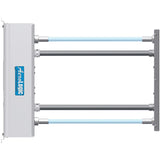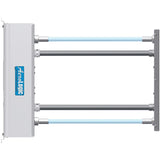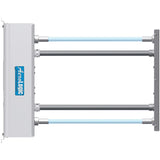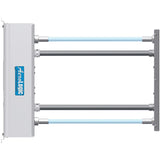Strategies for Reducing Virus Spread in Residential Care Facilities
Posted by Dave on for ProLampSales

In addition to the deadly and debilitating impacts of COVID-19, its spread within communities has also illuminated the inadequacies of basic prevention and control strategies in place at public facilities and institutions. One of the most glaring examples is residential care facilities.
There are currently (2021) over 16,000 nursing homes and long term care facilities in the U.S. Of the total confirmed COVID-19 cases in the U.S. as of April 2021, residential care facilities accounted for just 3%, but over 30% of the deaths. In addition, the virus spread very rapidly in these facilities even when isolation, mask, and distancing protocols were followed.
Case studies by the American Geriatrics Society document very rapid and widely disseminated outbreaks despite visitor exclusion, cessation of communal dining and group activities, regular resident and staff screenings, universal masking, and aggressive social distancing policies (Blackman et al. 2020).
In spite of best efforts by staff to contain the spread of the virus, the vulnerability of the population in these facilities and the lack of "built-in" pathogen control and mitigation strategies and equipment made it a nearly impossible task.
Increase Ventilation

ASHRAE Standard 170 calls for a minimum of two air changes per hour (ACH) in resident rooms and up to 12 ACH in isolation rooms. Most residential care facilities rely on existing HVAC equipment that maintains significantly fewer air changes per hour. In theory, better ventilation should result in fewer infections.
However, one study from the U.S. Department of Energy published in April 2021, Ventilation in Residential Care Environments, concluded better ventilation had a modest affect on controlling the spread of pathogens: "Increasing air change rates from 1 to 8 OACH, for example, reduced the contaminant load and potential exposure risk to healthcare workers from an infectious occupant by roughly half... This finding was consistent with results from other similar studies that found air change rates were not effective in proportionately reducing aerosol concentrations within hospital patient rooms."
See the complete study for additional insights.
Even if providing only a modest improvement, recommended ventilation levels did help and should be considered for these facilities
Install Ultraviolet (UV-C) Equipment
A recent article entitled "Ten Facts about UV Radiation and COVID-19," authored by Kevin Houser in the Journal of the Illumination Engineering Society, states "in healthcare settings, upper-air UV-C radiation systems should be expected to be a least partially effective for reducing viral transmission. When properly used (e.g., in unoccupied spaces or at heights that are out of reach and out of sight) UV-C can be employed to lessen the spread of COVID-19 by inactivating the SARS-CoV-2 virus in the air and on surfaces, including sterilization of personal protective equipment. This is especially important in settings where healthcare professionals are at risk."
The same could be said for UV-C equipment installed in HVAC ducts.
Both upper air and in-duct UV-C equipment has been available for decades and used in many hospitals and medical facilities. Equipment sizing for different spaces and types of buildings is well understood making the selection process straightforward.
Like improved ventilation, UV-C equipment is not the single fix that will eliminate the spread of pathogens. Most studies point to the need for a combination of strategies to achieve the highest level of protection.
Conclusion
Virtually all residential care facilities in the U.S. lack installed equipment and operation protocols that can provide pro-active control of pathogen spread among their residents. While no single measure - increased ventilation or UV-C equipment - can ensure 100% protection, the combination of both will make the use of masks, isolation and distancing that much more effective.
Featured Products (View All)
- 0 Comments
- Posted in Ultraviolet Light
0 Comments




